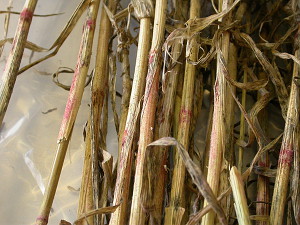 NIAB TAG pathologists have identified Fusarium culmorum as the fungus responsible for causing the striking pinkish red sporulation being found on the lower nodes of some winter wheat crops in the East of England.
NIAB TAG pathologists have identified Fusarium culmorum as the fungus responsible for causing the striking pinkish red sporulation being found on the lower nodes of some winter wheat crops in the East of England.
The later than usual development of Fusarium this year is the result of the dry spring and early summer. NIAB TAG is now assessing the incidence of the disease on different wheat varieties.
“The most commonly seen, and recognised, symptom of Fusarium infection is seedling blight during establishment or dark brown staining of lower nodes earlier in the season. However, on older plants Fusarium infection can produce a true foot rot,” explains NIAB TAG’s Dr Kerry Maguire.
A classic sign of late Fusarium infection is a pink colouration of the lower nodes. The stem base may then become brown and rotten leading to crop lodging. Some plants can also develop white heads containing shrivelled grain.
Dr Maguire assures growers that the risk to yield is minimal this late in the season. However she warns that infection may result in higher disease inoculum for subsequent second wheat sites so consider cultural control methods after harvest.
